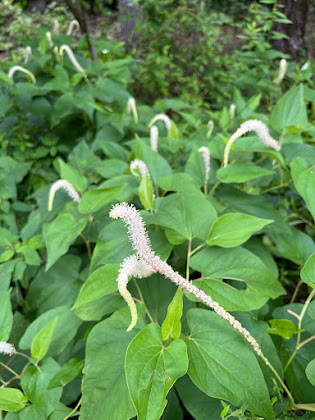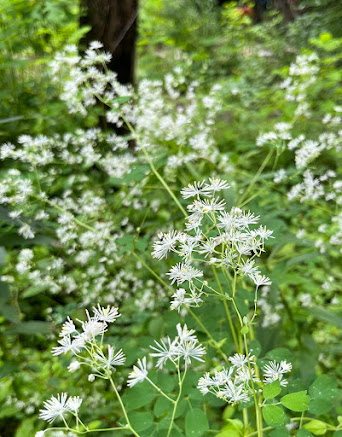Thanks to the municipality of Princeton for installing a new sign along Snowden Lane for Herrontown Woods. The sign was designed by a consultant with input from the town open space manager, Inga Reich.
Importantly, it includes an arrow to point visitors in the right direction, and a salamander to celebrate the various species of amphibians that call Herrontown Woods home. Thanks to Britt for these photos of salamanders she and her kids recently found in the preserve.Wednesday, September 24, 2025
A New Sign for Herrontown Woods
Friday, August 1, 2025
Our Annual Birthday Celebration of the Veblens
Every year we throw a Veblen Birthday Bash in June to honor Oswald and Elizabeth Veblens' role in founding the open space movement in Princeton. They were born on the 24th and the 2nd of June, respectively.
This year's celebration was particularly successful, with lots of socializing, lawn games, live music, and displays documenting our accomplishments and plans for the future.a special approach to circus called Circus Quercus, led by Zoe Brooks in the stone circle next to Veblen House,
our interns, Ninfa and Moss, funded by a grant from Green Matters,
a Herrontown Woods Community Collage project led by our board member and Artist in Residence, Hope Van Cleaf,
May's Garden Club led by master gardener Mathilde Burlion,
and scenes from our work this past year with Princeton High School students to manage two PHS detention basins for native flora.
Thursday, July 3, 2025
What's Bloomin' in the Barden? -- July 2, 2025
The Botanical Art Garden at Herrontown Woods, nicknamed the Barden and packed with more than 150 species of native plants, has a steady stream of blooms through the summer. This is a rich, complex, dynamic landscape that contrasts with the more static "trees n' turf" landscapes we tend to see around town. Walk the paths of the Barden and see if you can find the latest flowers to unfold.
Bottlebrush buckeye (Aesculus parviflora) is a popular shrub for landscaping. Native to the southeast U.S., it creates abundant flowers in the shape of a bottlebrush, pollinated by many kinds of insects, including the beautiful syrinx moth.The Barden is a special habitat seldom seen in Princeton. We intentionally manage it as an open woodland where shrubs get enough sunlight to form abundant berries for the birds. My love of elderberries extends back to childhood and the delicious pies and jellies we made from its berries, which will turn dark purple when ripe.
Monday, May 26, 2025
Pagoda Dogwood -- A Comeback Story
It was a great surprise, many years ago, when I first encountered a pagoda dogwood in Herrontown Woods. Though its leaves have the classically arc-shaped veins, this is not the highly ornamental flowering dogwood. Nor is it the silky dogwood often found in floodplains. Also called alternate-leaved dogwood (Cornus alternifolia), its discovery took me back to field botany days in the 1970s, when a charismatic University of Michigan botanist, Herb Wagner, introduced us to many of the less common flora.
I'm guessing the discovery in Herrontown Woods was about ten years ago, and at that time I could find only two specimens of pagoda dogwood in the preserve. One was thriving, the other dying, possibly of an introduced anthracnose disease. Encountering no others, I assumed the species was barely hanging on and in danger of succumbing altogether.Monday, May 19, 2025
Herrontown Woods in the News -- Salamanders and Wet Meadows
There have been some excellent recent writeups in local news media about the Friends of Herrontown Woods' work in the community, in Town Topics, TapInto Princeton, and the PPS District News.
The first was by Carolyn Jones in TapInto Princeton, entitled "How To Save the Salamanders? In Princeton a Volunteer Brigade Helps Out," about FOHW's Princeton Salamander Crossing Brigade--a group put together by FOHW board member Inge Regan that includes community volunteers, high school students, teachers, professors--all taking a keen interest in helping amphibians migrate safely across Herrontown Road in the spring on their way to vernal pools, where they lay their eggs.Saturday, April 26, 2025
Princeton Grad Students Help Out at Herrontown Woods
One of my favorite things to do at Herrontown Woods is to restore habitat with a group of grad students from SPIA. That's the Princeton School of Policy and International Affairs, formerly known as the Woodrow Wilson school.
It was one of those inspiring spring days, when the shadbush is in bloom,
when the opulent leaves of skunk cabbage form green ribbons along the streams,
and when newborn tadpoles nibble algae growing around masses of salamander eggs in a vernal pool.
We decided to work in an area of intense restoration, where years of work had finally slain a giant 3-acre wisteria monster, making room for native species to be planted.
Rebecca and Nadia planted loci of native seed--ironweed, JoePyeWeed, and coneflower--covering the seed with a thin layer of soil and tamping it down.
Mariah, Derek, and Matteo made cages to protect newly planted elderberry shrubs from browsing deer.
A pileated woodpecker had preceded us, chowing down on insects hidden in a fallen log. Such a pleasure to participate in nature's dynamic cycling of life with a spirited crew at Herrontown Woods.
Tuesday, March 25, 2025
Late Winter Blooms at Veblen House
Even before spring officially begins its sweep through the landscape, the Veblen House grounds come alive with blooms.
Particularly prolific in expanse and blooms are the snowdrops that grace the grounds with white in mid-March, echoing the patches of lichen on the boulders. Down below the Veblen House, near the fishpond, are some other early wildflowers mixed in: crocuses, the yellow of winter aconite, and the blue flowers of Scilla, also called Siberian squill. All of these flowers are nonnative, but they do not spread into the surrounding woodlands.Wednesday, March 19, 2025
Soft Open for Firmer Trails at Autumn Hill Reservation
If you haven't been to Autumn Hill Reservation in a while, this would be a good time to check it out. A three year revisioning of the trails to make them drier and more scenic is now essentially complete, and we're doing what could be called a "soft open" on the newest sections.
Signs give hikers a gentle nudge away from the old trails and towards the new. This winter's revisions bypass wet areas and follow ridgelines and historic rockwalls that date back to when this land was farmed 100+ years ago.Our wonderful mapmaker from Maine, Alison Carver, is already converting my scrawl and tracking files into a new map. The new configuration, with a new "blue" trail, should give hikers more options for exploring the preserve.



















































